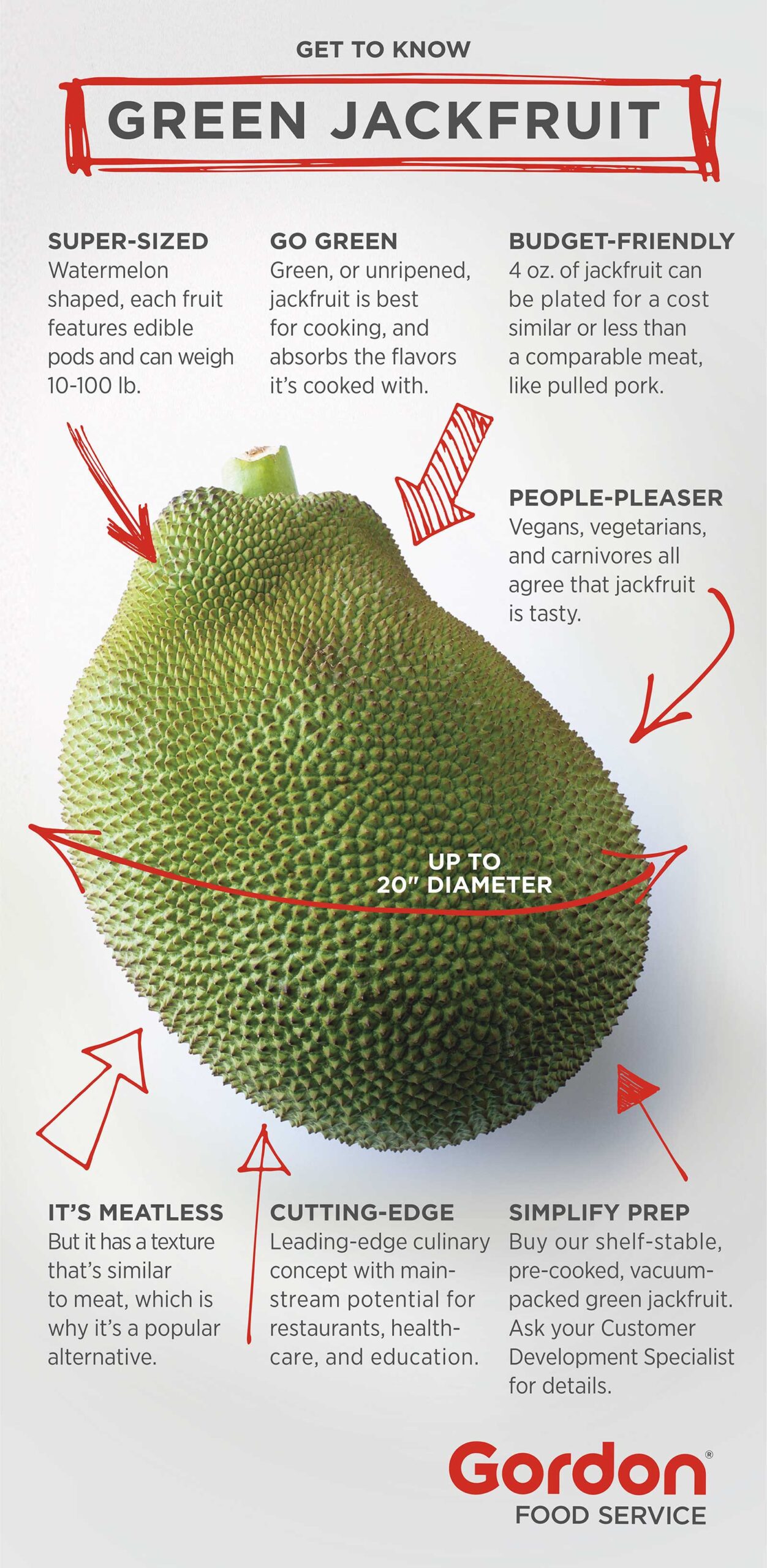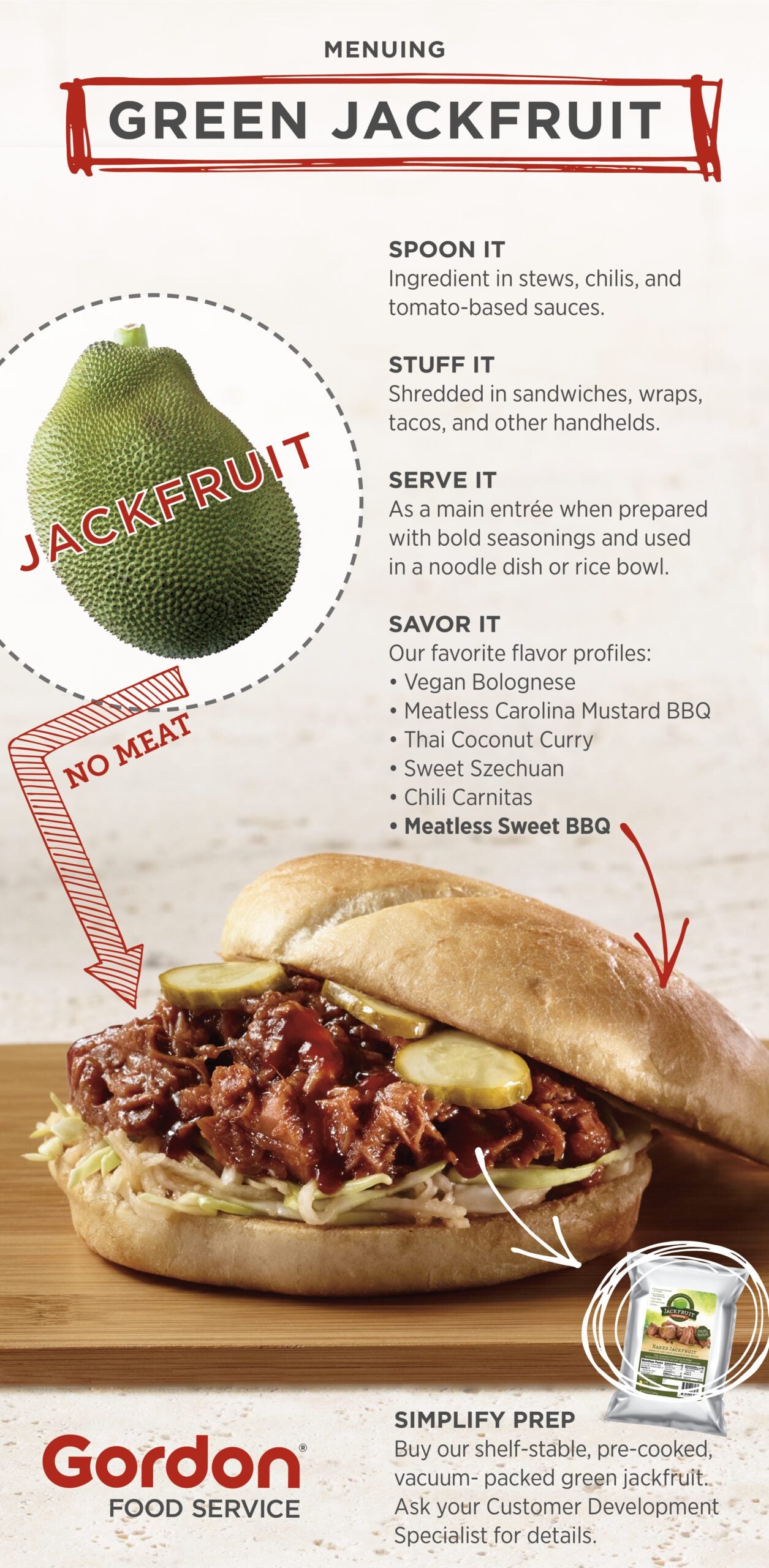Operators seeking a potentially giant menu opportunity need look no further than the giant jackfruit. This fruit is a versatile menu player, poised to become the jack of all menu parts—from appetizer to center of the plate and beyond. It has potential as a nutritional superstar ingredient that will appeal to vegans, vegetarians, and carnivores alike.
Never heard of it? That’s not surprising. The watermelon-shaped jackfruit ranges from 10 to 100 pounds and grows in trees common throughout Southeast Asia. Each prickly fruit is filled with edible golden-yellow pods. When ripe, the flesh from these pods can be eaten fresh and it is traditionally used in sweet and savory dishes. The unripe, or green, jackfruit flesh must be cooked, resulting in a fibrous composition that can be shredded and combined with a barbecue sauce to create a flavor and texture very similar to pulled pork.

In his recent research tour, Gordon Food Service Corporate Consulting Chef Gerry Ludwig, CEC, said jackfruit appeared on only three menus—one location in New York City and two in the Los Angeles area. “Our research group was extremely impressed with the jackfruit dishes we tasted,” Ludwig says. “Operators who get in on it now have a real opportunity at clear menu differentiation.”
Operators in both the commercial and non-commercial segments can save the difficulty of dissecting a giant jackfruit to remove the edible pods by buying the value-added product available through Gordon Food Service. The vacuum-packed, pre-cooked green jackfruit is available in shelf-stable packages that simplify the preparation process. Contact your Customer Development Specialist to purchase it.
“Four ounces of jackfruit can be plated for a cost similar or even less than a comparable meat, such as pulled pork,” Ludwig says. “And when properly finished with a sauce or seasoning, it has flavor and texture superior to other meat analogs such as tofu or tempeh.”
Because of its texture and ability to take on many flavor profiles, operators can use jackfruit in many ways. It can be braised and shredded to make a filling for sandwiches, wraps, tacos, and other handhelds. As a center of the plate entrée, it can be prepared with bold seasonings and used in a noodle dish or rice bowl. As an ingredient, it can be used in stews, chili, or tomato-based sauces.
Jackfruit has a sweet flavor and slightly floral aroma on its own. But none of that matters, Ludwig says, when you prepare it with seasonings and sauces. It has the ability to absorb and present the flavors it’s cooked with. That’s how it’s able to pair as well with a dry rub and barbecue sauce as it is with a marinara.
“In our testing, we prepared a vegan Bolognese that was superb,” Ludwig says. “You would never know it lacked a meat component.”

This flavor variety means jackfruit can appear as chili carnitas nachos on a sports bar appetizer menu, as a sweet Szechuan rice bowl on the entrée menu, or as a Thai coconut curry on a bao bun for takeout.
In non-commercial operations, Ludwig believes college and university dining is a real sweet spot. Gen Z diners and young millennials are experimenting with vegan, vegetarian, and other diets, and jackfruit fits right into any of those menus—and it does so in a healthy way. There are only about 95 calories in a half-cup serving, plus it is rich in protein, potassium, calcium, and iron.
That makes jackfruit an option for healthcare dining, particularly hospital cafeterias searching for a vegetarian or vegan option, Ludwig says.
“Operators who want to do some menu trials or limited-time offers will be on the leading edge with a concept that is absolutely delicious, Ludwig says. “Jackfruit will quickly expand in popularity once diners taste it—it truly has mainstream potential.”
DID YOU KNOW?
While promoting dishes made from jackfruit, operators can engage customers with the tree’s rich history and cultural importance:
- Why “jackfruit?” The name most likely came from the Portuguese explorers, who called the fruit “jaca,” a shortened version of the Indian name “koozha chakka.”
- It’s all relative. Jackfruit trees are part of the mulberry family.
- National pride. Jackfruit is the national fruit of Bangladesh.
- Fruit bonanza. Trees can grow up to 150 jackfruit pods over its two harvest seasons each year.
- Commercially rich. The tree bark is orange, and the dye made from it is used to color monks’ robes. When cut, the trees produce a sticky latex substance used in glues. Jackfruit wood is used to make furniture and musical instruments.




























